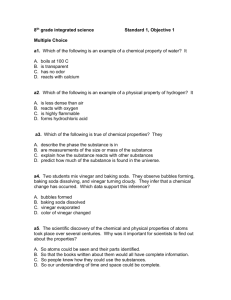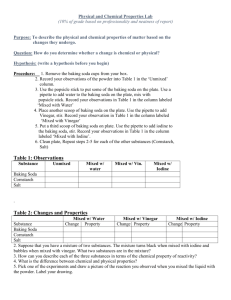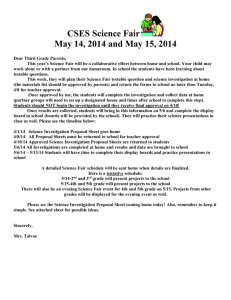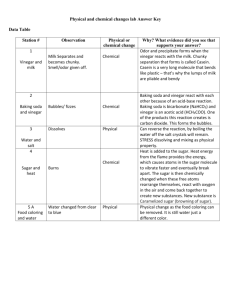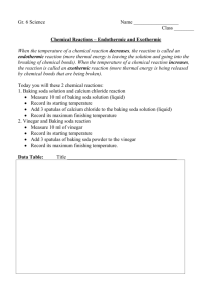Vinegar and Baking Soda Investigation
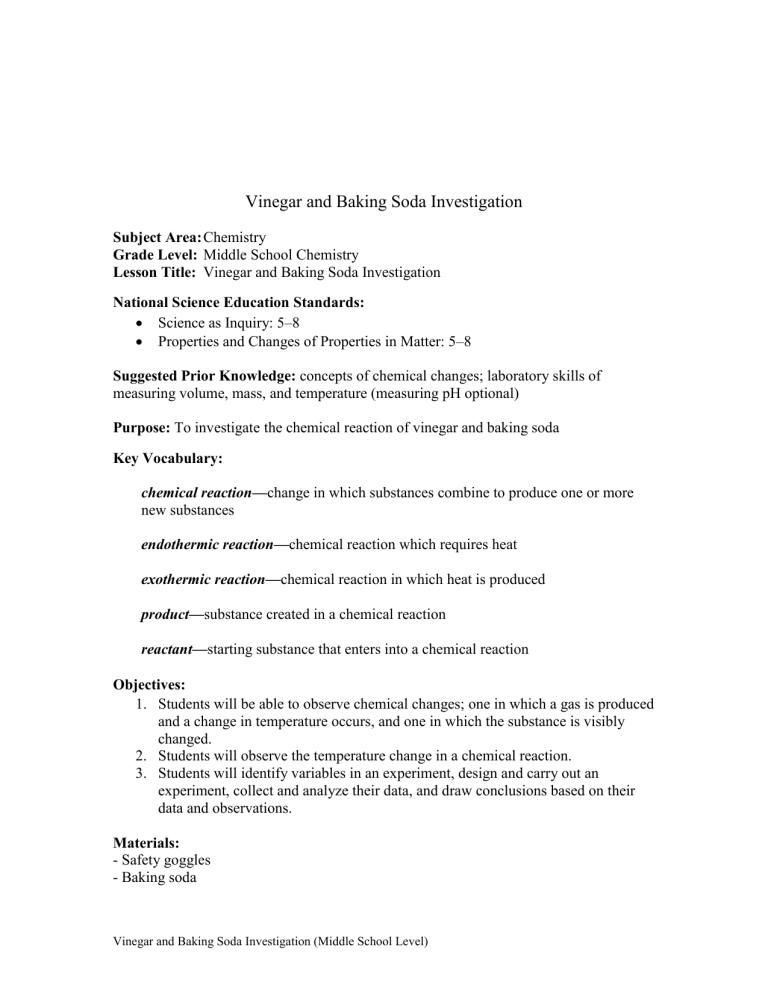
Vinegar and Baking Soda Investigation
Subject Area: Chemistry
Grade Level: Middle School Chemistry
Lesson Title: Vinegar and Baking Soda Investigation
National Science Education Standards:
Science as Inquiry: 5–8
Properties and Changes of Properties in Matter: 5–8
Suggested Prior Knowledge: concepts of chemical changes; laboratory skills of measuring volume, mass, and temperature (measuring pH optional)
Purpose: To investigate the chemical reaction of vinegar and baking soda
Key Vocabulary: chemical reaction— change in which substances combine to produce one or more new substances endothermic reaction— chemical reaction which requires heat exothermic reaction— chemical reaction in which heat is produced product— substance created in a chemical reaction reactant— starting substance that enters into a chemical reaction
Objectives:
1.
Students will be able to observe chemical changes; one in which a gas is produced and a change in temperature occurs, and one in which the substance is visibly changed.
2.
Students will observe the temperature change in a chemical reaction.
3.
Students will identify variables in an experiment, design and carry out an experiment, collect and analyze their data, and draw conclusions based on their data and observations.
Materials:
- Safety goggles
- Baking soda
Vinegar and Baking Soda Investigation (Middle School Level)
- Vinegar (white)
- Reaction vessel without lids (small, clear, plastic soda bottle works great)
- Thermometers
- pH probe (optional)
- balloon (optional)
Procedure:
1. Put the following substances on the board and ask the students what makes up these substances—what are the reactants and what is the product? How are the elements different from the substances they make when they are combined?
Water Sodium Chloride Carbon dioxide
2. Review with students the steps of the scientific method. In this investigation students will explore the chemical and physical properties of baking soda and vinegar and the chemical reaction that occurs between these two substances.
3. This activity introduces these substances and the reaction between them: a. Obtain a small, clear, plastic soda bottle. b. Measure 50 ml of vinegar in a graduated cylinder. c. Measure 2 g of baking soda. d. Place the baking soda in the bottle and pour in the vinegar. Observe the reaction that occurs; be sure to touch the bottle to feel the temperature change.
4. As a concluding discussion, begin with a leading question and some follow-up questions:
Did you notice a temperature change? (at this point define exothermic and endothermic with the students).
What was produced from this chemical reaction?
What are the physical properties of vinegar and baking soda?
How do these properties change when the two substances react?
What kind of investigation can we do to learn more about these substances and/or this reaction?
How can we measure some of the changes taking place?
5 .
Some possible researchable questions include the following:
What is the density of vinegar?
What is the pH of vinegar?
What is the boiling point of vinegar?
How does the temperature of the vinegar change when it reacts with baking soda?
What gas is produced?
How does the odor of the vinegar change during this reaction?
How does the pH of the vinegar change during this reaction?
How can the temperature change be maximized?
How can the quantity of gas formed be maximized?
Vinegar and Baking Soda Investigation (Middle School Level)
6. Some possible alternate or additional procedures: How can we investigate temperature change and pH change? a. Temperature change during the reaction:
Obtain a reaction vessel.
Measure 50 ml of vinegar and place it in the vessel.
Measure and record the initial temperature of the vinegar.
Discuss with the class: Now we know that adding baking soda will create a chemical reaction and a temperature change. Can you design an experiment that will answer the question, Can we get to a final temperature? Ask the students to design this experiment and discuss before implementing. Then allow students to implement the procedure and record results. b. Change in pH of vinegar during the reaction:
Same basic procedure as above for temperature change but measuring the pH of the vinegar initially and after the reaction occurs. Ask students to design an experiment that will demonstrate changes in pH. What variables in their experiment have to be changed to change the pH? Discuss their possible experiments and then implement and record results.
7. After the students have finished their investigation, they should be able to present their data and observations in appropriate data tables and/or graphs. They should be able to identify their variables and their control. They should be able to explain what they learned through their research and investigation.
8. Students may present their findings to their classmates in a slide show or on a poster.
Additional Resources: http://www.flinnsci.com/Sections/Safety/safety.asp http://www.enzyme-facts.com/properties-of-vinegar.html http://www.suite101.com/content/properties-and-uses-of-sodium-bicarbonate-a89020 http://library.thinkquest.org/3347/vinegar%2Bbsoda4.html http://experimentopia.org/?/experiment/baking_soda_and_vinegar/ http://wiki.answers.com/Q/What_happens_when_baking_soda_and_vinegar_are_combin ed http://antoine.frostburg.edu/chem/senese/101/reactions/faq/classify-vinegarbakingsoda.shtml
Vinegar and Baking Soda Investigation (Middle School Level)
Student Worksheet for Vinegar and Baking Soda Investigation
Experiment Title: _____________________________Date: _______Name: __________
Student Hypothesis/Question:
________________________________________________________________________
Materials:
________________________________________________________________________
________________________________________________________________________
________________________________________________________________________
Safety Precautions:
________________________________________________________________________
________________________________________________________________________
________________________________________________________________________
Procedure:
Wear safety goggles for all lab work.
_______________________________________________________________________
_______________________________________________________________________
_______________________________________________________________________
_______________________________________________________________________
_______________________________________________________________________
_______________________________________________________________________
_______________________________________________________________________
_______________________________________________________________________
_______________________________________________________________________
Vinegar and Baking Soda Investigation (Middle School Level)
Data and Observations :
Vinegar and Baking Soda Investigation (Middle School Level)
Analysis of Data: _________________________________________________________
________________________________________________________________________
________________________________________________________________________
________________________________________________________________________
________________________________________________________________________
________________________________________________________________________
________________________________________________________________________
Conclusion: _____________________________________________________________
________________________________________________________________________
________________________________________________________________________
________________________________________________________________________
________________________________________________________________________
Vinegar and Baking Soda Investigation (Middle School Level)

